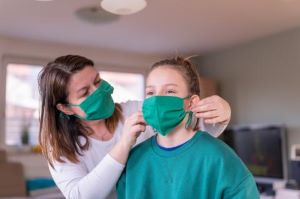
Masks have become a necessary (and, let’s hope, a temporary) way of life in Arizona and throughout the nation. To curb the spread of COVID-19, cities across the state now require kids and adults to wear face coverings in public spaces.
At Phoenix Children’s, our first priority is to prioritize the health and safety of our patient families and the providers who care for them: We require masks for all employees, visitors and patients 2 years and older.
Of course, putting a mask on a child is much easier said than done. It’s a brand-new concept for most children – masks may seem weird, uncomfortable and even scary – but these 10 tips will ease your kids’ worries and help them get comfortable with the idea:
- Explain: Share with your child that doctors and nurses recommend we all wear masks to protect ourselves and others from COVID-19. Masks aren’t scary – they keep the germs away. Learn more about talking to kids about COVID-19.
- Validate: If your children have concerns or fears about wearing a mask, practice patience and validate their experience. This will help them process their feelings and feel a measure of control in a difficult situation.
- Personalize: Letting kids pick out the color or pattern of their cloth face mask – like dinosaurs, princesses, superheroes or puppies – will give them a sense of ownership and make the experience feel more normal.
- Decorate: Encourage your children to decorate their masks (think fabric markers or iron-on patches). This will allow them to feel some control over the situation. They’ll also be proud to show off their masterpieces.
- Button up: If your kids complain that masks hurt their ears, try attaching buttons to a hat or a cloth headband. You can loop the elastic around the buttons rather than your child’s ears.
- Practice: First, help your kids practice putting a mask on a doll or stuffed animal. Then, teach them how to put a mask on (and take it off) their own faces – all by themselves.
- Plan: Wearing a mask is a big adjustment. Build in plenty of time for your kids to get used to wearing one before going out in public or coming to Phoenix Children’s. Wear them around the house to normalize the experience.
- Play: With a younger child, make it fun. Let your child pretend to be a doctor or nurse while wearing a mask. They can check your temperature, put on a Band-aid or "take care" of their favorite stuffed animal.
- Model: If your little one is afraid, play peek-a-boo to show your child that you are the same person with or without a mask. Look in the mirror together – with masks on and off – to help them get comfortable. Show them pictures of other kids and parents wearing masks.
- Praise: Use positive reinforcement – like praise or small rewards – when your child wears a mask.
The CDC recommends a simple, cloth mask that snugly (but comfortably) covers the nose and mouth. This will help preserve N95 respirators and surgical masks for health care workers. There are exceptions, of course: Children who are considered high risk or severely immunocompromised may require an N95 mask. Kids who have certain developmental issues, underlying breathing difficulties, and children under 24 months of age should not wear masks at all.
